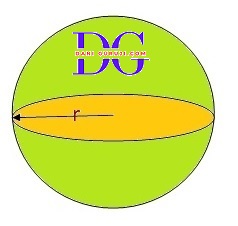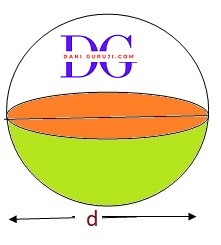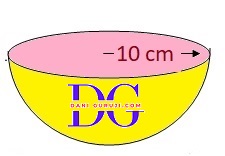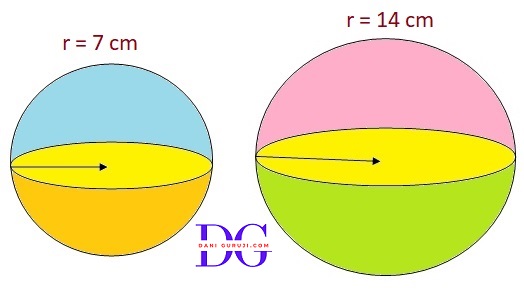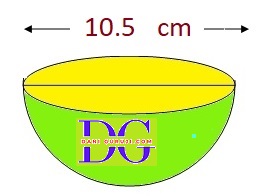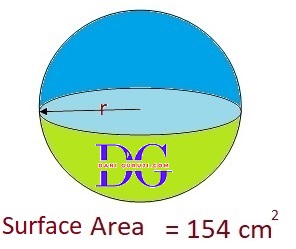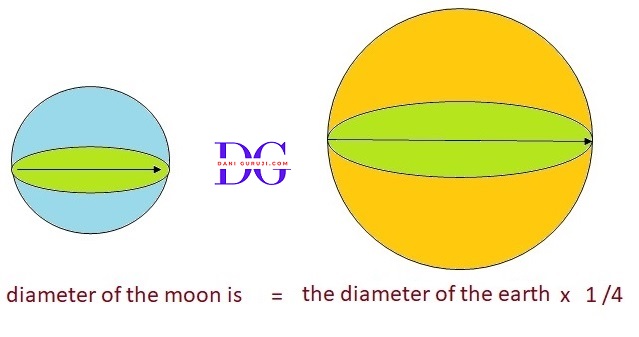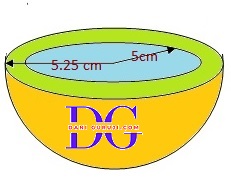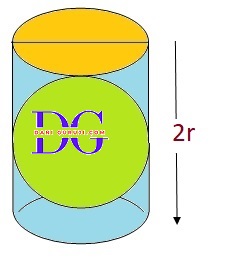Assume, $ { \pi} $ = 22/7, unless stated otherwise
Find the surface area of a sphere of radius:
(i) 10.5 cm (ii) 5.6 cm (iii) 14 cm
Solution :
The surface area of a sphere is calculated using the formula :$ 4{ \pi}× r^2$
(i) Radius = 10.5 cm
Surface area of a sphere = $ 4{ \pi}× r^2$.
$$ 4 × { 22 \over 7} × (10.5)^2 $$
$$ 4 × { 22 \over 7} × 10.5 × 10.5 $$
$$ 4 × 22 × 1.5 × 10.5 $$
$$⇒ 1386 cm^2 $$
The surface area of the sphere with a radius of 10.5 cm = $ {1386 } cm^2 $
(ii) Radius = 5.6 cm
Surface area of a sphere = $ 4{ \pi}× r^2$.
$$ 4 × { 22 \over 7} × (5.6)^2 $$
$$ 4 × { 22 \over 7} × 5.6 × 5.6 $$
$$ 4 × 22 × 0.8 × 5.6 $$
$$⇒ 394.24 cm^2 $$
The surface area of the sphere with a radius of 5.6 cm = $ {394.24 } cm^2 $
(iii) Radius = 14 cm
Surface area of a sphere = $ 4{ \pi}× r^2$.
$$ 4 × { 22 \over 7} × (14)^2 $$
$$ 4 × { 22 \over 7} × 14 × 14 $$
$$ 4 × 22 × 2 × 14 $$
$$⇒ 2464 cm^2 $$
The surface area of the sphere with a radius of 14 cm = $ {2464 } cm^2 $
Find the surface area of a sphere of diameter:
(i) 14 cm (ii) 21 cm (iii) 3.5 m
Solution :
The surface area of a sphere is calculated using the formula :$ 4{ \pi}× r^2$
(i) Diameter of sphere = 14 cm
Given, Diameter of the sphere = 14 cm
Therefore, The radius is half of the diameter.
$$ { { 1 \over 2} × 14 } $$
$$⇒ r = {7 }cm $$
Surface area of a sphere = $ 4{ \pi}× r^2$.
$$ 4 × { 22 \over 7} × (7)^2 $$
$$ 4 × { 22 \over 7} × 7 × 7 $$
$$ 4 × 22 × 7 $$
$$⇒ 616 cm^2 $$
The Surface area of a sphere = $ {616 } cm^2 $
(i) Diameter of sphere = 21 cm
Given, Diameter of the sphere = 21 cm
Therefore, The radius is half of the diameter.
$$ { { 1 \over 2} × 21 } $$
$$⇒ r = { 10.5} cm $$
Surface area of a sphere = $ 4{ \pi}× r^2$.
$$ 4 × { 22 \over 7} × (10.5)^2 $$
$$ 4 × { 22 \over 7} × 10.5 × 10.5 $$
$$ 4 × 22 × 1.5 × 10.5 $$
$$⇒ 1386 cm^2 $$
The Surface area of a sphere = $ {1386 } cm^2 $
(i) Diameter of sphere = 3.5 cm
Given, Diameter of the sphere = 3.5 cm
Therefore, The radius is half of the diameter.
$$ { { 1 \over 2} × 3.5 } $$
$$⇒ r = { 1.75} cm $$
Surface area of a sphere = $ 4{ \pi}× r^2$.
$$ 4 × { 22 \over 7} × (1.75)^2 $$
$$ 4 × { 22 \over 7} × 1.75 × 1.75 $$
$$ 4 × 22 × 0.25 × 1.75 $$
$$⇒ 38.5 cm^2 $$
The Surface area of a sphere = $ {38.5 } cm^2 $
Find the total surface area of a hemisphere of radius 10 cm.(Use π = 3.14)
Solution :
Radius of hemisphere (r) = 10 cm
Total surface area of hemisphere = $ 3{ \pi}× r^2$.
$$ 3 × 3.14 × (10)^2 $$
$$⇒ 3 × 3.14 × 10 × 10 $$
$$ ⇒ 942 cm^2 $$
Total surface area of hemisphere = = $ {942 } cm^2 $
The radius of a spherical balloon increases from 7 cm to 14 cm as air is being pumped into it. Find the ratio of surface areas of the balloon in the two cases
Solution :
The surface area of a sphere is calculated using the formula :$ 4{ \pi}× r^2$
Case I : when Radius = 7 cm
Surface area of a sphere = $ 4{ \pi}× r^2$.
$$ 4{ \pi} × (7)^2 $$
Case II : when Radius = 14 cm
Surface area of a sphere = $ 4{ \pi}× r^2$.
$$ 4{ \pi} × (14)^2 $$
Now, Required ratio = SA in first case / SA in second case
$$⇒ {{4{ \pi} × (7)^2} \over {4{ \pi} × (14)^2} } $$
$$⇒ { {7 × 7} \over { 14 × 14} } $$
$$⇒ { 1 \over 4} $$
The ratio of the surface areas of the balloons = 1: 4
A hemispherical bowl made of brass has an inner diameter 10.5 cm. Find the cost of tin-plating it on the inside at the rate of Rs 16 per 100 $cm^2$. (Assume π = 22/7)
Solution :
Given, Diameter of the sphere = 10.5 cm
Therefore, The radius is half of the diameter.
$$ { { 1 \over 2} × 10.5 } $$
$$⇒ r = {5.25 }cm $$
Radius of hemisphere (r) = 5.25 cm
Surface area of hemispherical bowl = $ 2{ \pi}× r^2$.
$$ 2 × { 22 \over 7} × (5.25)^2 $$
$$⇒ 2 × { 22 \over 7} × 5.25 × 5.25 $$
$$⇒ 2 × 22 × 0.75 × 5.25 $$
$$ ⇒ 173.25 cm^2 $$
Surface area of hemispherical bowl = = $ {173.25 } cm^2 $
Find the Cost of tin-plating
Cost of tin-plating per 100 $cm^2$ = Rs. 16
Cost of tin-plating for 173.25 $cm^2$ area=
$$⇒ {{ 16 \over 100} × 173.25 } $$
$$⇒ {27.72 } $$
Therefore, the cost of tin-plating the inner side of the hemispherical bowl = Rs. 27.72
Find the radius of a sphere whose surface area is 154 $cm^2$. (Assume π = 22/7)
Solution :
Surface area of sphere = 154 $cm^2$
Let the radius of the sphere be r.
Surface area = = $ 4{ \pi}× r^2$
$$ 154 = 4 × { 22 \over 7} × (r)^2 $$
$$⇒ (r)^2 = {{154 × 7} \over {22 × 4}} $$
$$ ⇒ (r)^2 ={{7 × 7} \over {4}} $$
$$ ⇒ (r)^2 =({{7 } \over {2}})^2 $$
$$ ⇒ r ={7 \over 2} = 3.5 cm. $$
The radius of the sphere is 3.5 cm
The diameter of the moon is approximately one fourth of the diameter of the earth. Find the ratio of their surface areas.
Solution :
Given that the diameter of the moon is approximately one-fourth of the diameter of the earth:
If diameter of earth is said d, then radius of Earth (r) = d/2
Since the diameter is twice the radius (d = 2r), this also means the radius of the moon is one-fourth of the radius of the earth .
Radius of moon = ${ 1 \over 4} × { d \over 2}$
Radius of moon = ${ d \over 8} $
Surface area of a sphere = $ 4{ \pi}× r^2$.
Since, the earth as well as the moon are considered to be spheres.
The surface area of the moon :
$$⇒ {{4{ \pi} × ({ d \over 8})^2} } $$
The surface area of the earth :
$$⇒ {{4{ \pi} × ({ d \over 2})^2} } $$
Ratio of their Surface areas =
$$⇒ {{4{ \pi} × ({ d \over 8})^2} } \over {{4{ \pi} × ({ d \over 2})^2} }$$
$$⇒ { 4 \over {64}}$$
$$⇒ { 1 \over {16}}$$
The ratio of the surface areas of the moon and the earth is 1:16.
A hemispherical bowl is made of steel, 0.25 cm thick. The inner radius of the bowl is 5cm. Find the outer curved surface of the bowl. (Assume π =22/7)
Solution :
Find the Outer Radius of the hemispherical bowl
The outer radius of the bowl is the sum of its inner radius and the thickness of the steel.
$$⇒ { r = 5 cm + 0.25 cm = 5.25 }cm $$
Find the Outer Curved Surface Area
Surface area of hemispherical bowl = $ 2{ \pi}× r^2$.
$$ 2 × { 22 \over 7} × (5.25)^2 $$
$$⇒ 2 × { 22 \over 7} × 5.25 × 5.25 $$
$$⇒ 2 × 22 × 0.75 × 5.25 $$
$$ ⇒ 173.25 cm^2 $$
Outer Curved Surface Area of hemispherical bowl = $ {173.25 } cm^2 $
A right circular cylinder just encloses a sphere of radius r (see fig.).
(i) Find surface area of the sphere,
{ii) curved surface area of the cylinder,
(iii) ratio of the areas obtained in (i) and (ii).
Solution :
(i) Surface area of the sphere = $ 4{ \pi}× r^2$, where r is the radius of sphere
(ii) For cylinder :
∵ Radius of the cylinder = Radius of the sphere
∴ Radius of the cylinder base = r
Height of the cylinder = Diameter of the sphere
[As sphere touches both upper and lower surface of cylinder]
Height of the cylinder (h) = r + r = 2r
CSA of the cylinder formula = 2πrh
$ = 2πr× (2r) $
= ${ 4{\pi} r^2 }$
(iii) Ratio between areas = $ { {(Surface Area Of Sphere)} \over {(CSA Of Cylinder)} }$
$$⇒ { { 4{\pi} r^2 } \over {{ 4{\pi} r^2 }} }$$
$$⇒ { 1 \over 1 }$$
Syllabus for class 10
Advanced courses and exam preparation.
Previous Year Paper
Advanced courses and exam preparation.
Mock Test
Explore programming, data science, and AI.
